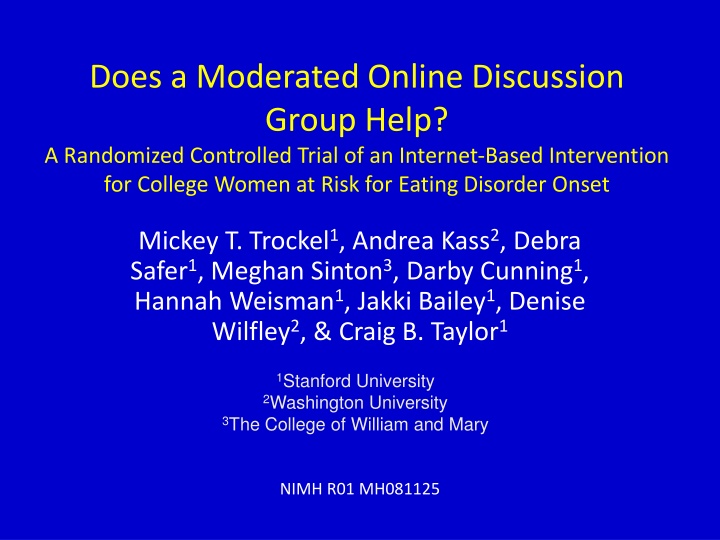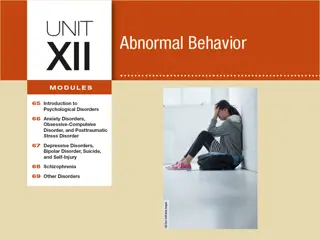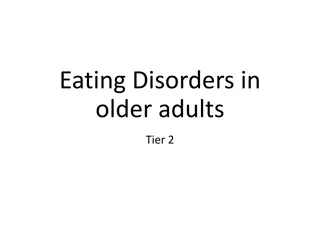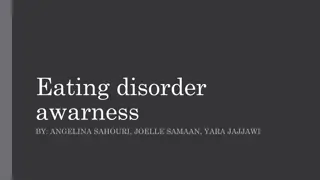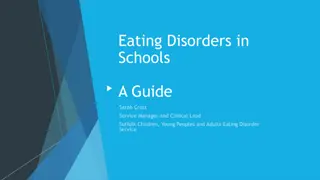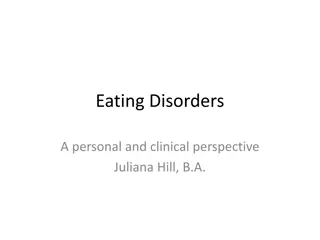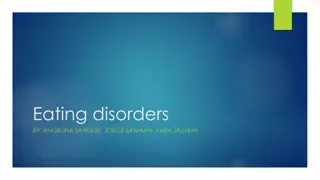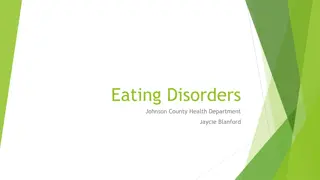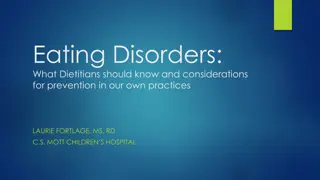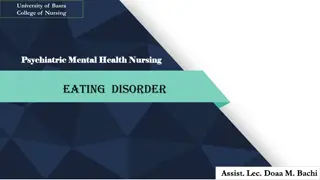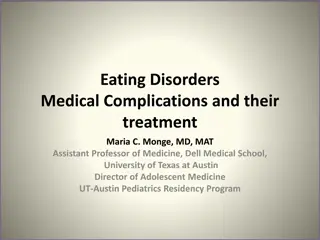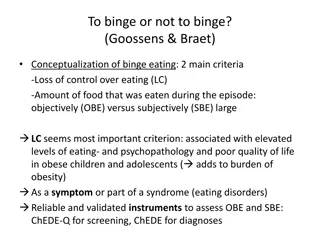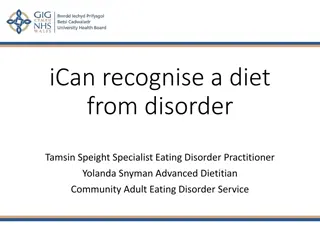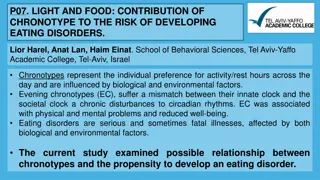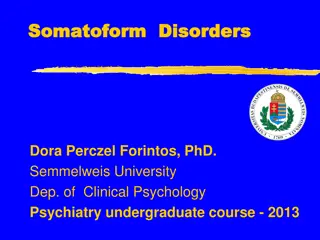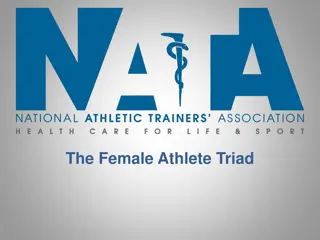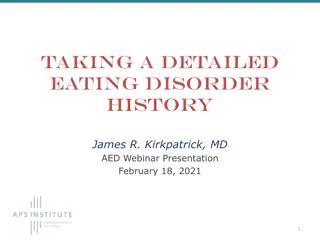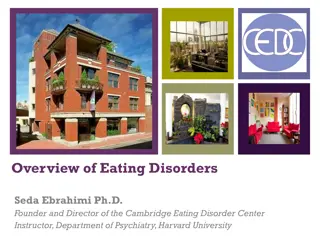Online Discussion Group for Eating Disorder Prevention in College Women
This study explores the effectiveness of a moderated online discussion group as an internet-based intervention for college women at risk for eating disorder onset. The research focuses on the impact of the group on participants and seeks to determine if all individuals benefit equally from this type of intervention. Eating disorders are highlighted as serious mental disorders affecting a significant portion of the population, with subclinical symptoms being particularly prevalent. The aim is to develop and disseminate interventions that can be readily delivered to reduce disease burden, improve public health, and enhance overall quality of life.
Download Presentation

Please find below an Image/Link to download the presentation.
The content on the website is provided AS IS for your information and personal use only. It may not be sold, licensed, or shared on other websites without obtaining consent from the author.If you encounter any issues during the download, it is possible that the publisher has removed the file from their server.
You are allowed to download the files provided on this website for personal or commercial use, subject to the condition that they are used lawfully. All files are the property of their respective owners.
The content on the website is provided AS IS for your information and personal use only. It may not be sold, licensed, or shared on other websites without obtaining consent from the author.
E N D
Presentation Transcript
Does a Moderated Online Discussion Group Help? A Randomized Controlled Trial of an Internet-Based Intervention for College Women at Risk for Eating Disorder Onset Mickey T. Trockel1, Andrea Kass2, Debra Safer1, Meghan Sinton3, Darby Cunning1, Hannah Weisman1, Jakki Bailey1, Denise Wilfley2, & Craig B. Taylor1 1Stanford University 2Washington University 3The College of William and Mary NIMH R01 MH081125
Overview Need for dissemination research Use of Internet-based interventions for the prevention of eating disorders Current study Effect of moderated discussion group Does a moderated group benefit all participants equally? (possible effect modifiers)
Dissemination Science Top clinical research priority NIMH Strategic Plan Evidence-based interventions are not being delivered in routine clinical care Not only bench to bedside but also bedside to practice Goal: develop disseminable interventions that are Readily deliverable Rely less on specialists Effective for varied levels of risk and symptom profiles Beidas & Kendall, 2010, Clin Psychol; Drake et al., 2001, Psychiatr Serv; Insel, T. R., 2009, Arch Gen Psychiatry ; Proctor et al., 2009, Adm Policy Ment Health; Shafran et al., 2009, Behav Res Ther
Preventive Interventions Designed to manipulate a risk factor(s) that places individuals at risk for disorder onset Goal: curb the incidence of a disorder/illness or the worsening of detectable clinical symptoms Reduce disease burden and health care costs Improve public health and overall quality of life
Eating Disorders Eating disorders (EDs) are serious mental disorders Affect ~4.4% of the population Subclinical symptoms more prevalent Significant medical and psychological morbidity High mortality and suicide rates Often comorbid with other mental disorders APA, 2006, Am J Psychiatry; Grilo et al., 2003, IJED; Herzog et al., 2000, IJED; Hudson, et al., 2007, Biol Psychiatry; Jacobi et al., 2004, Psychol Bull; Keel et al., 1999, Arch Gen Psychiatry; Lewinsohn et al., 2000, JAACAP; Stice et al., 2009, J Abnorm Psychol; Strober et al., 1997, IJED
Why Focus on Eating Disorder Prevention?
Why Focus on Eating Disorder Prevention? Concerns about weight/shape are prominent Excessive weight concerns linked to subclinical and clinical EDs ~25% of college women have high preoccupation with weight and body dissatisfaction Often don t seek treatment Chronic course Only 50% recover; 30% show some improvement Effective treatments exist, but relapse is common High health-care costs Herzog et al., 1999, JAACAP; Taylor et al. ,2006, Arch Gen Psychiatry
Preventative Interventions for Eating Disorders Larger effects for prevention programs which are interactive (vs. didactic) multi-session (vs. single session) offered solely to women (vs. offered to both sexes) targeted for individuals at risk (vs. universal) Stice et al., 2007, Annu Rev Clin Psychol; Shaw et al., 2008, Child Adolesc Psychiatr Clin N Am
Student Bodies CONTACT First developed in 1998 at Stanford University and San Diego State University 8-week online intervention Targets core risk factors for EDs Interactive components: Cognitive-behavioral focus Personal exercises and self-monitoring logs Asynchronous, online moderated discussion group
Student Bodies: Research Trajectory Tested with over 1,000 women Research trajectory: Feasibility testing Large randomized controlled prevention trials Results replicated in Germany Expanding for use in Australia Beintner, Jacobi & Taylor (under review); Bruning Brown et al., 2004, J Adolesc Health; Celio et al., 2000, JCCP; Dev et al., 1999 Proc AMIA Symp; Jones et al., 2008, Pediatrics; Winzelberg et al., 2000, JCCP
Student Bodies Decreases Risk for ED Onset in High-Risk Groups To our knowledge, Survival as a non-case for students with low-level compensatory behaviors at baseline this is the first study to show that EDs can be prevented in high-risk groups. Survival as a non-case for students with BMI > 25 at baseline
Given its Efficacy, What Now? Large-scale dissemination on college campuses Need to maximize cost efficiency Highest costs associated with the intervention is the moderated discussion group What is the clinical utility of the Discussion Group?
Current Study: Aims & Hypotheses Aim: Determine whether the discussion group is necessary to yield clinically significant reductions in ED risk Discussion Group (DG) versus No Discussion Group (NDG) Assess changes in weight/shape concerns Null Hypothesis: The two conditions are equally effective
Why this study is important Economic cost of the moderated group: Cost of moderated group = moderator hours X moderator per-hour salary Moderators time spent moderating discussion group, per student was approximately 2 hours across entire 9 week intervention We estimate per-hour moderator salary = $24 USD Cost of moderated group = 2 X $24 = $48 USD per participant. This incremental cost may be prohibitive for wide dissemination among college students at risk
The Discussion Group Purpose: Open, confidential forum to discuss reactions, provide/receive support, seek advice/ask questions Anonymous username Moderator role: Reinforce program participation, post weekly question(s) about session content, and encourage continued dialogue Moderator postings based on a manual from previous trials Checked postings 1/day to ensure safety and appropriateness
Participants and Procedure Two-site RCT comparing DG and NDG conditions Recruited through flyers, emails to student groups, SHS, Facebook, Volunteers for Health, word of mouth Inclusion criteria: Female, ages 18-25, BMI >18 No current clinical or subclinical ED (history okay) Not suicidal or psychotic Procedure: Screened for risk status (WCS 47) In-person assessment Received intervention (all participants) Online post-intervention assessment
Measures Weight & Shape Concerns Scale (WCS) Assesses disordered eating attitudes Range: 0-100 (Higher scores = greater weight/shape concerns) Cut-off of 47: approximately 25% of women in this category develop an eating disorder within three years without intervention Beck Depression Inventory, 2nd version (BDI-2) Assesses negative affect Range: 0-63 (Higher scores = worse mood) Motivation Scale Two subscales assessing 1) Willingness to work on improving body image, and 2) willingness to work on improving emotion regulation and stress management Range (each sub-scale): 0-4 average item score (Higher scores = more motivation) Body Mass Index (BMI; kg/m2) and demographics Jacobi et al., 2004, IJED; Killen et al., 1996, JCCP; Killen et al., 1994, IJED; Orme et al., 1986, J Clin Psychol; Plutchik & van Praag, 1987, Psychiatry Res
Adherence Tracked electronically Quantified in three ways: Whether users ever logged on to the program Time spent using the program (in minutes) Number of session pages viewed
Analyses Modified intent-to-treat (that is, all post-test assessment completers included, regardless of program use) Independent sample t-tests and chi-square analyses to examine baseline differences and adherence between conditions Independent sample t-test to determine effect of discussion group on change in WCS Logistic regression to test difference in risk status category at post-test Regression to explore possible moderators of the effect of the discussion group on change in WCS
Flowchart of Study Participation Randomized to the intervention N = 151 Completed post-test data N = 111 Did not complete post-test data N = 40 NDG = 59 DG = 22 NDG = 18 DG = 52 Cohort 1 = 12 Cohort 2 = 16 Cohort 3 = 12 Cohort 4 = 12 Cohort 1 = 16 Cohort 2 = 14 Cohort 3 = 10 Cohort 4 = 19
Baseline Characteristics: Completers vs. Non-Completers Variable Completers (n=111) Non-completers (n=40) p-value DG condition Discussion Group n=52 n=22 0.46 No Discussion Group n=59 n=18 Age 21 20 0.17 Site Washington University n=56 n=16 0.27 Stanford University n=55 n=24 Race/Ethnicity White n=74 (66.7%) n=17 (42.5%) Black/African American n=9 (8.1%) n=5 (12.5%) 0.09 Chinese/Chinese American n=8 (7.2%) n=3 (7.5%) Hispanic/Latina n=6 (5.4%) n=4 (10.0%) Mixed/Other n=14 (12.6%) n=11 (27.5%) BMI 24.9 (4.2) 26.0 (7.0) 0.25 Parent Education Some graduate school College graduate 0.03*
Baseline Characteristics: DG vs. NDG Discussion Group (n=52) No Discussion Group (n=59) Variable p-value Age 21 21 0.90 Site Washington University n=28 n=28 0.57 Stanford University n=24 n=31 Race/Ethnicity White n=36 (69.2%) n=40 (67.8%) Black/African American n=4 (7.7%) n=5 (8.5%) 0.78 Chinese/Chinese American n=3 (5.8%) n=5 (8.5%) Hispanic/Latina n=1 (1.9%) n=4 (6.8%) Mixed/Other n=8 (15.3%) n=5 (8.5%) BMI 25.2 (4.8) 24.6 (3.6) 0.45 Parent Education Some graduate school Some graduate school 0.87 WCS 56.8 (17.9) 58.1 (18.4) 0.70 BDI-2 9.7 (9.0) 8.0 (7.3) 0.29
Program Adherence 75/111 (67.6%) participants logged on DG: n=34/52 (65%) and NDG:n=41/59 (69%)a Total Hours Logged In Pages Viewed Per Session 9 5 * 8 4 7 6 3 5 4 2 3 2 1 1 0 0 DG NDG DG NDG t(73)=-2.3; p=0.02* t(73)=-1.3; p=0.18 aNS difference
Pre-Post Changes in WCS Scores Between group difference in change = -9.3 (CI = -3.2 -15.5); t(109) = -3.03; p= 0.003; Cohen s D = -0.51
Effects of Moderated Discussion Group on Dichotomous Risk Status (WCS > 47) Logistic regression results: Controlling for baseline WCS scores, odds of having high risk weight and shape concerns (WCS > 47) post-intervention were 69% lower for participants assigned to the moderated discussion group condition, compared to no discussion group participants.
Exploratory Effect-Moderator Analysis Is there a subgroup of students who benefit most from the online moderated discussion group? Possible effect moderators tested: Depression symptoms (BDI-2 scores) Willingness to work on body image (4 item scale) Willingness to work on management of emotions and stress (4 item scale)
Results of Exploratory Effect- Moderator Analysis Standardized Coefficient (Beta) Unstandardized Coefficient (SE) Significance Discussion group -8.85 (2.84) -0.23 0.002 WCS at baseline 0.61 (0.08) 0.56 < 0.001 BDI at baseline 0.36 (0.18) 0.15 0.047 Parent education 1.99 (1.00) 0.15 0.050 Willingness to work on management of emotions and stress 3.82 (2.23) 0.15 0.090 (Discussion group) X (willingness to work on management of emotions and stress) -9.39 (3.94) -0.21 0.019 -Dependent variable: WCS score at post-test -All variables except treatment condition were centered
Pre-Post Changes in WCS Scores (Exploratory effect-moderator analysis) Baseline Post-test Baseline Post-test 59.2 58.9 57.1 56.9 60 60 56.1 55 50 50 45.8 42.7 40 40 30 30 20 20 10 10 0 0 DG, n= 25 High willingness to work on management of emotions/stress No-DG, n= 24 DG, n = 19 Low willingness to work on management of emotions/stress No-DG, n= 25
Summary of Primary Finding Changes in weight and shape concerns significantly better for DG than NDG participants Demonstrates greater reductions in risk for ED onset Suggests a clinically meaningful benefit to including the discussion group component with Student Bodies
Possible Explanations Discussion group provides: Accountability (to group; moderator) Interpersonal support Both provide and receive Consistent with studies of online support groups for EDs Outlet to cope with negative affect McCormack, 2010, Comput Inform Nurs; Ranson et al., 2010, IJED; Wesemann & Grunwald, 2008, IJED
Quotes from Discussion Group Users This program definitely forced me to take a critical look at my body image, and I do believe that these past few months have helped me to challenge a lot of the thoughts I was having on a regular basis in favor of a more positive outlook on myself. I have decided not to diet nor worry about my appearance anymore because I know I do better [ ] if I focus on the things that are most important in my life. Since starting the program I have been successful in identifying both the large and small events in my life that can cause me to feel insecure, and I have been able to reflect on them. The journey was fun, and I will continue this journey now that I have some tools in place.
Limitations Short duration of follow-up Previous studies suggest differences become more pronounced over time No control condition Efficacy already established Change in WCS: d=0.81 at post-test; d=0.42 at 1-year High-intensity comparator (i.e., two active treatments) allowed for careful examination of treatment differences Design prevents us from parsing out whether differences due to discussion group or moderator Future examination: keep the discussion group but do not include an active moderator
Conclusions Additive clinical benefit of the discussion group Appreciate that overall costs are lower than in-person treatment The Discussion Group is an important component of the evidence-based Student Bodies program, shown to be effective for the prevention of EDs in high-risk subgroups
Questions/Comments? Thank You!
